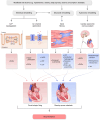2024 European Heart Rhythm Association/Heart Rhythm Society/Asia Pacific Heart Rhythm Society/Latin American Heart Rhythm Society expert consensus statement on catheter and surgical ablation of atrial fibrillation
- PMID: 38587017
- PMCID: PMC11000153
- DOI: 10.1093/europace/euae043
2024 European Heart Rhythm Association/Heart Rhythm Society/Asia Pacific Heart Rhythm Society/Latin American Heart Rhythm Society expert consensus statement on catheter and surgical ablation of atrial fibrillation
Corrected and republished in
-
2024 European Heart Rhythm Association/Heart Rhythm Society/Asia Pacific Heart Rhythm Society/Latin American Heart Rhythm Society expert consensus statement on catheter and surgical ablation of atrial fibrillation.Heart Rhythm. 2024 Sep;21(9):e31-e149. doi: 10.1016/j.hrthm.2024.03.017. Epub 2024 Apr 8. Heart Rhythm. 2024. PMID: 38597857 Review.
Abstract
In the last three decades, ablation of atrial fibrillation (AF) has become an evidence-based safe and efficacious treatment for managing the most common cardiac arrhythmia. In 2007, the first joint expert consensus document was issued, guiding healthcare professionals involved in catheter or surgical AF ablation. Mounting research evidence and technological advances have resulted in a rapidly changing landscape in the field of catheter and surgical AF ablation, thus stressing the need for regularly updated versions of this partnership which were issued in 2012 and 2017. Seven years after the last consensus, an updated document was considered necessary to define a contemporary framework for selection and management of patients considered for or undergoing catheter or surgical AF ablation. This consensus is a joint effort from collaborating cardiac electrophysiology societies, namely the European Heart Rhythm Association, the Heart Rhythm Society, the Asia Pacific Heart Rhythm Society, and the Latin American Heart Rhythm Society .
Keywords: Atrial fibrillation; Catheter ablation; Surgical ablation.
This article has been co-published with permission in Europace, HeartRhythm, Journal of Arrhythmia and Journal of Interventional Cardiac Electrophysiology. © 2024 Heart Rhythm Society, the European Society of Cardiology, the Asia Pacific Heart Rhythm Society, and the Latin American Heart Rhythm Society The articles are identical except for minor stylistic and spelling differences in keeping with each journal's style. Any citation can be used when citing this article.
Conflict of interest statement
Conflict of interest: All members provided disclosure statements to assess potential conflicts of interest. Details are available in the Supplementary material.
Figures















References
-
- Calkins H, Brugada J, Packer DL, Cappato R, Chen SA, Crijns HJ, et al. HRS/EHRA/ECAS expert consensus statement on catheter and surgical ablation of atrial fibrillation: recommendations for personnel, policy, procedures and follow-up. A report of the Heart Rhythm Society (HRS) task force on catheter and surgical ablation of atrial fibrillation developed in partnership with the European Heart Rhythm Association (EHRA) and the European Cardiac Arrhythmia Society (ECAS); in collaboration with the American College of Cardiology (ACC), American Heart Association (AHA), and the Society of Thoracic Surgeons (STS). Endorsed and approved by the governing bodies of the American College of Cardiology, the American Heart Association, the European Cardiac Arrhythmia Society, the European Heart Rhythm Association, the Society of Thoracic Surgeons, and the Heart Rhythm Society. Europace 2007;9:335–79. - PubMed
-
- Calkins H, Kuck KH, Cappato R, Brugada J, Camm AJ, Chen SA, et al. 2012 HRS/EHRA/ECAS expert consensus statement on catheter and surgical ablation of atrial fibrillation: recommendations for patient selection, procedural techniques, patient management and follow-up, definitions, endpoints, and research trial design: a report of the Heart Rhythm Society (HRS) task force on catheter and surgical ablation of atrial fibrillation. Developed in partnership with the European Heart Rhythm Association (EHRA), a registered branch of the European Society of Cardiology (ESC) and the European Cardiac Arrhythmia Society (ECAS); and in collaboration with the American College of Cardiology (ACC), American Heart Association (AHA), the Asia Pacific Heart Rhythm Society (APHRS), and the Society of Thoracic Surgeons (STS). Endorsed by the governing bodies of the American College of Cardiology Foundation, the American Heart Association, the European Cardiac Arrhythmia Society, the European Heart Rhythm Association, the Society of Thoracic Surgeons, the Asia Pacific Heart Rhythm Society, and the Heart Rhythm Society. Heart Rhythm 2012;9:632–96.e21. - PubMed
-
- January CT, Wann LS, Calkins H, Chen LY, Cigarroa JE, Cleveland JC Jr, et al. 2019 AHA/ACC/HRS focused update of the 2014 AHA/ACC/HRS guideline for the management of patients with atrial fibrillation: a report of the American College of Cardiology/American Heart Association task force on clinical practice guidelines and the Heart Rhythm Society in collaboration with the Society of Thoracic Surgeons. Circulation 2019;140:e125–51. - PubMed
-
- Hindricks G, Potpara T, Dagres N, Arbelo E, Bax JJ, Blomstrom-Lundqvist C, et al. 2020 ESC guidelines for the diagnosis and management of atrial fibrillation developed in collaboration with the European Association for Cardio-Thoracic Surgery (EACTS): the task force for the diagnosis and management of atrial fibrillation of the European Society of Cardiology (ESC) developed with the special contribution of the European Heart Rhythm Association (EHRA) of the ESC. Eur Heart J 2021;42:373–498. - PubMed

